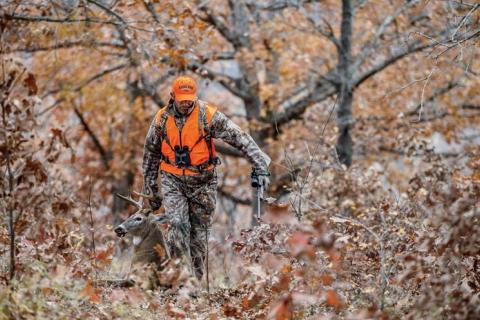
6 Tips for Tagging a Whitetail from the Ground
1. Increased mobility is perhaps the greatest advantage to hunting deer from a ground blind made from existing natural cover.
 |
| Standing behind a clump of tree trunks growing from one root allows Cavanaugh to hide behind individual trunks depending on the direction of approaching deer. Trucks also provide a solid shooting rest. |
Ground blinds enable hunters to choose stand locations all through hunting season without any advance scouting or preparation. I am a firm believer in pre-season scouting, however I also scout all through the deer season. Deer often change their habits abruptly during the fall of the year, and when they do hunters must respond quickly. If you have several blinds prepared in advance, you can move quietly from one to another throughout the day, while searching for where deer are most active.
2. Deer hunting from the ground enables you to hunt a new location every day, which impedes deer from patterning your movements.
I usually have my best success encountering mature bucks when I hunt a location for the first time, whether it’s from the ground or a tree. You can hunt a new location every day from tree stands, but it takes a lot of stands, and a lot of preparation. When I’m scouting I mark dozens of potential blind locations on my topo maps, or you could mark them on a handheld GPS like the popular and highly customer rated Garmin Montana 680t Handheld GPS Unit. I go back to some of the blinds later that week, some later that year; others I don’t return to for 2 or 3 years, and some I never return to. Lots of little Xs on my map keeps me sporadic.
3. You are often better concealed in a natural cover ground blind that you would be in a treestand.
Deer have learned to look up. They frequently watch the skyline, or just above it. When hunters are backlit against the sky, any movement they make can be seen from far; much farther than a deer with forest in back of it can seen by the hunter from an elevated position. Hunters are most vulnerable to being seen when they are climbing or descending above the understory during daylight hours. You can slide into a ground blind without making any movement above the understory, and it’s much quieter than climbing a stand.
4. The two basic rules for concealment in the forest are: get behind something, and stay in the shadows.
 Available natural cover in any type of woods is the often the best source for concealment. Hide in back of the tree, in its shadow—not in front of it. Strive to be adaptable and quick to identify available blind cover in various forest types. In hardwood forests, I’ve found clumps of 3-5 tree trunks growing out of one root conceal me quite well. Standing in back of a clump of trees allows me to dodge behind different trunks, depending on which way the deer is approaching, and offers various fields of fire with a solid trunk for a rest. The tops of fallen trees and piled up deadfalls also make good blinds; as well as willows or alder, though obtaining a field of view can be difficult from a brush blind. Concealment in conifer forests is usually easier to find. Standing next to the trunk of a spruce, fir, or cedar that has bows reaching the ground will surely put you in the shadows. You can peer through the bows while being totally concealed by dense natural cover. Conifers provide some of the best natural cover there is for ground blinds. I once had a timber wolf come within 7 yards of me when I was in spruce blind. The drawback to standing around conifers is sap on your hunting clothes.
Available natural cover in any type of woods is the often the best source for concealment. Hide in back of the tree, in its shadow—not in front of it. Strive to be adaptable and quick to identify available blind cover in various forest types. In hardwood forests, I’ve found clumps of 3-5 tree trunks growing out of one root conceal me quite well. Standing in back of a clump of trees allows me to dodge behind different trunks, depending on which way the deer is approaching, and offers various fields of fire with a solid trunk for a rest. The tops of fallen trees and piled up deadfalls also make good blinds; as well as willows or alder, though obtaining a field of view can be difficult from a brush blind. Concealment in conifer forests is usually easier to find. Standing next to the trunk of a spruce, fir, or cedar that has bows reaching the ground will surely put you in the shadows. You can peer through the bows while being totally concealed by dense natural cover. Conifers provide some of the best natural cover there is for ground blinds. I once had a timber wolf come within 7 yards of me when I was in spruce blind. The drawback to standing around conifers is sap on your hunting clothes.
5. A clean spot of bare ground to stand on will allow you to adjust your stance without making noise, as you move slightly to stay out of sight or to get into shooting position.
 |
| Wicked Tree Gear Wicked Tough Hand Saw |
This only takes a minute. I usually do this while scouting, when I mark my spots on a map.
6. Many blinds will require that at least a few branches be cut, broke, bent over, or tied out of the way in order to have a clear view and line of fire.
Ideally, preparations are done months in advance, although with some care all preparations can be done upon arrival to a new spot during hunting season. On public land where it is prohibited to cut live vegetation, 1/8” parachute cord or similar material allows you to bend branches and tie them out of the way. Untie them when you leave and everything returns to normal. A folding saw, machete, or hatchet is indispensible for preparing ground blinds on land where you can cut branches. To get up close to conifer trunks you’ll most likely have to take out a few branches.
Being adaptive and staying mobile are keys to taking good bucks. Being repetitive is the key to failure. Hunt a new spot every morning from a well-concealed position on the ground and your luck is bound to change.
![]() Tip: Find more tips and information about hunting deer at Bass Pro 1Source.
Tip: Find more tips and information about hunting deer at Bass Pro 1Source.
- 32295 views

